An Analysis of Decision Support Systems: Effectiveness and Performance
VerifiedAdded on 2023/04/21
|9
|2150
|185
Report
AI Summary
This report examines the perceived effectiveness of Decision Support Systems (DSS) within organizations and their impact on overall performance. The study, based on secondary research and thematic analysis, explores the variations in DSS usage across industries, the value added by the technology, and its effects on both organizational and employee performance. It highlights the strengths of DSS, such as data-driven decision-making and time-saving benefits, while also acknowledging weaknesses, including the potential to overlook emotional factors and employee perspectives. The report analyzes three core themes: variations of DSS and its usage, impacts and value addition of the technology, and organizational and employee performance. The conclusion emphasizes the effectiveness of DSS in managerial decision-making while cautioning against neglecting the human element and employee satisfaction. The report also discusses the need for a balance between technological solutions and human considerations, suggesting that a well-implemented DSS can significantly improve company performance, but it is not a complete replacement for human judgment.
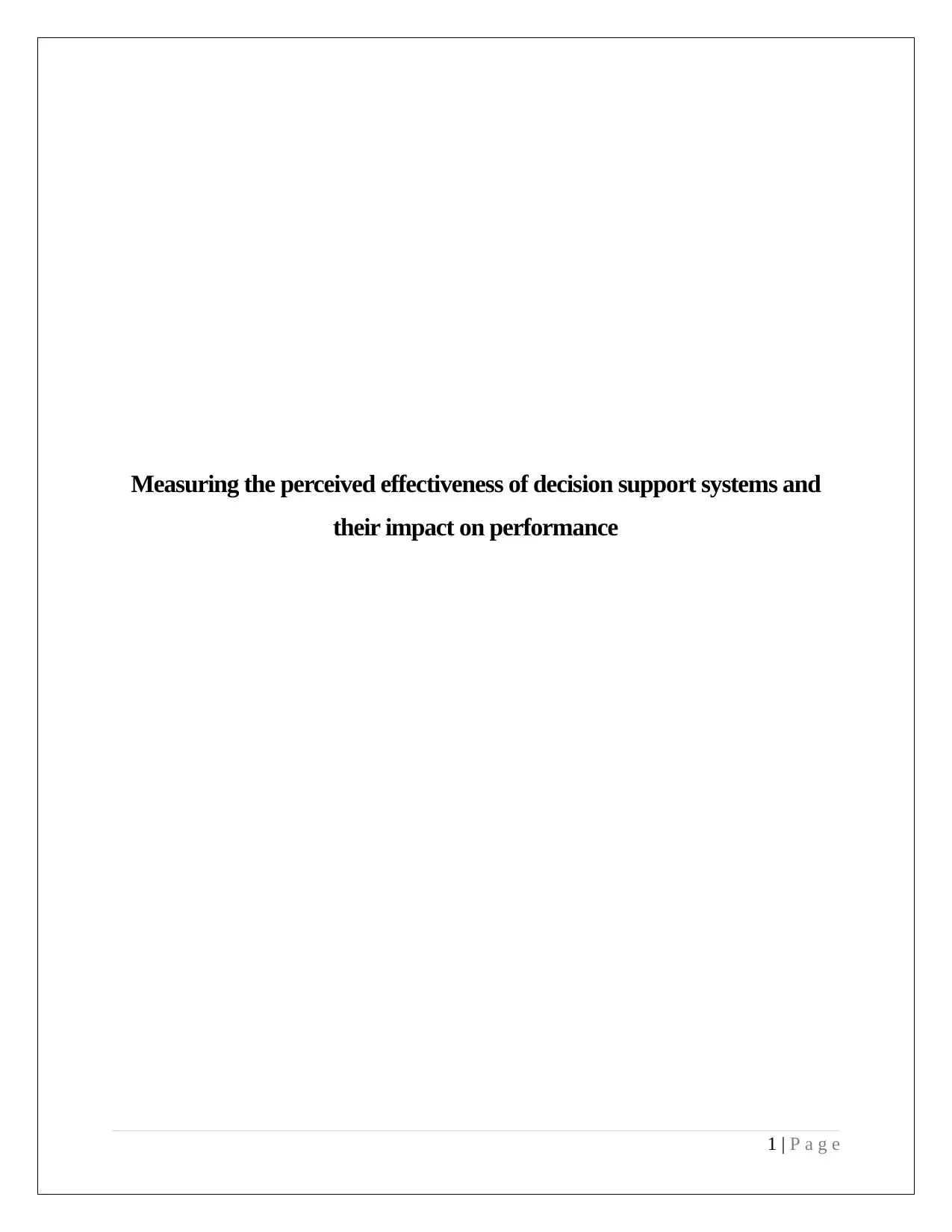
Measuring the perceived effectiveness of decision support systems and
their impact on performance
1 | P a g e
their impact on performance
1 | P a g e
Paraphrase This Document
Need a fresh take? Get an instant paraphrase of this document with our AI Paraphraser

Table of Contents
Introduction......................................................................................................................................3
Body.................................................................................................................................................3
Conclusion.......................................................................................................................................8
Reference.........................................................................................................................................8
2 | P a g e
Introduction......................................................................................................................................3
Body.................................................................................................................................................3
Conclusion.......................................................................................................................................8
Reference.........................................................................................................................................8
2 | P a g e
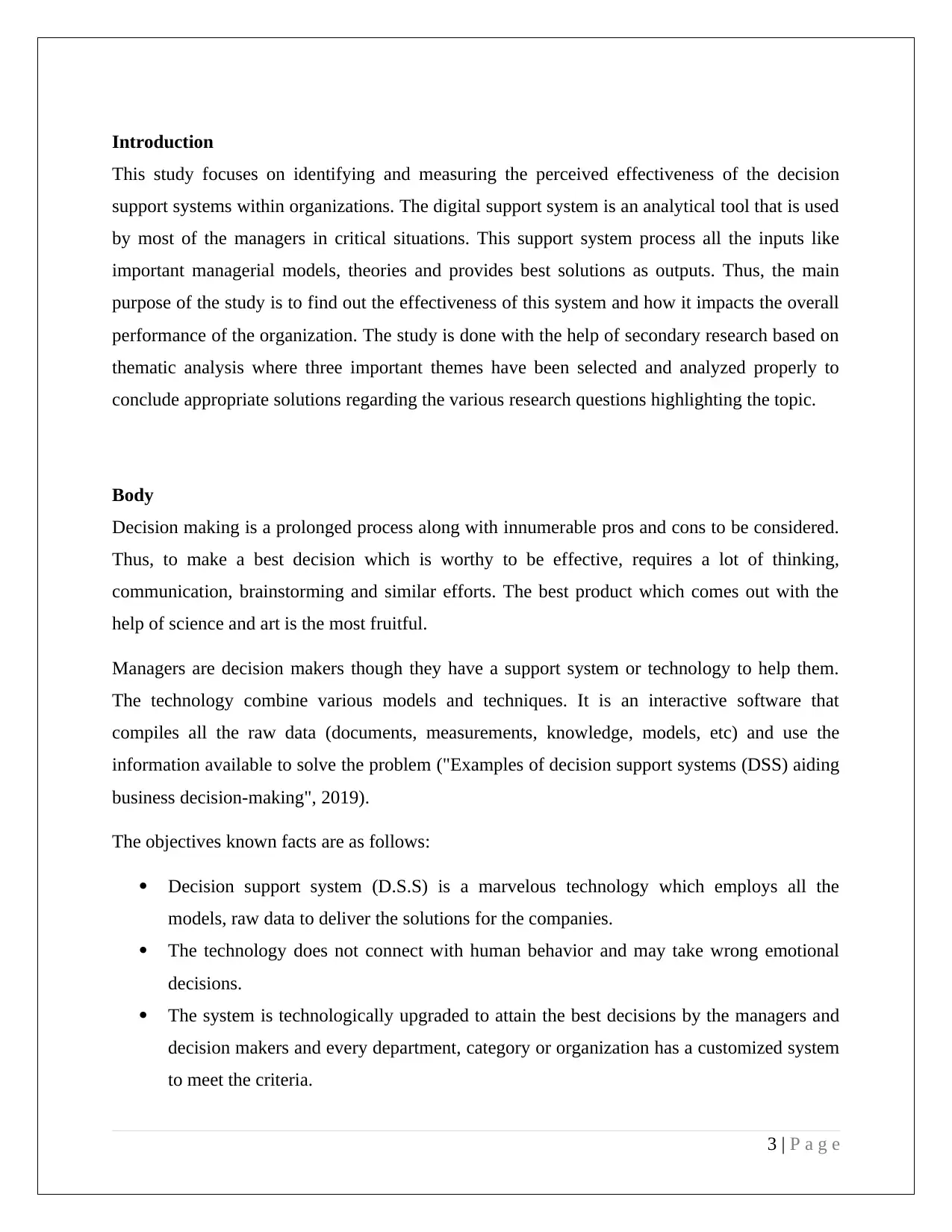
Introduction
This study focuses on identifying and measuring the perceived effectiveness of the decision
support systems within organizations. The digital support system is an analytical tool that is used
by most of the managers in critical situations. This support system process all the inputs like
important managerial models, theories and provides best solutions as outputs. Thus, the main
purpose of the study is to find out the effectiveness of this system and how it impacts the overall
performance of the organization. The study is done with the help of secondary research based on
thematic analysis where three important themes have been selected and analyzed properly to
conclude appropriate solutions regarding the various research questions highlighting the topic.
Body
Decision making is a prolonged process along with innumerable pros and cons to be considered.
Thus, to make a best decision which is worthy to be effective, requires a lot of thinking,
communication, brainstorming and similar efforts. The best product which comes out with the
help of science and art is the most fruitful.
Managers are decision makers though they have a support system or technology to help them.
The technology combine various models and techniques. It is an interactive software that
compiles all the raw data (documents, measurements, knowledge, models, etc) and use the
information available to solve the problem ("Examples of decision support systems (DSS) aiding
business decision-making", 2019).
The objectives known facts are as follows:
Decision support system (D.S.S) is a marvelous technology which employs all the
models, raw data to deliver the solutions for the companies.
The technology does not connect with human behavior and may take wrong emotional
decisions.
The system is technologically upgraded to attain the best decisions by the managers and
decision makers and every department, category or organization has a customized system
to meet the criteria.
3 | P a g e
This study focuses on identifying and measuring the perceived effectiveness of the decision
support systems within organizations. The digital support system is an analytical tool that is used
by most of the managers in critical situations. This support system process all the inputs like
important managerial models, theories and provides best solutions as outputs. Thus, the main
purpose of the study is to find out the effectiveness of this system and how it impacts the overall
performance of the organization. The study is done with the help of secondary research based on
thematic analysis where three important themes have been selected and analyzed properly to
conclude appropriate solutions regarding the various research questions highlighting the topic.
Body
Decision making is a prolonged process along with innumerable pros and cons to be considered.
Thus, to make a best decision which is worthy to be effective, requires a lot of thinking,
communication, brainstorming and similar efforts. The best product which comes out with the
help of science and art is the most fruitful.
Managers are decision makers though they have a support system or technology to help them.
The technology combine various models and techniques. It is an interactive software that
compiles all the raw data (documents, measurements, knowledge, models, etc) and use the
information available to solve the problem ("Examples of decision support systems (DSS) aiding
business decision-making", 2019).
The objectives known facts are as follows:
Decision support system (D.S.S) is a marvelous technology which employs all the
models, raw data to deliver the solutions for the companies.
The technology does not connect with human behavior and may take wrong emotional
decisions.
The system is technologically upgraded to attain the best decisions by the managers and
decision makers and every department, category or organization has a customized system
to meet the criteria.
3 | P a g e
⊘ This is a preview!⊘
Do you want full access?
Subscribe today to unlock all pages.

Trusted by 1+ million students worldwide
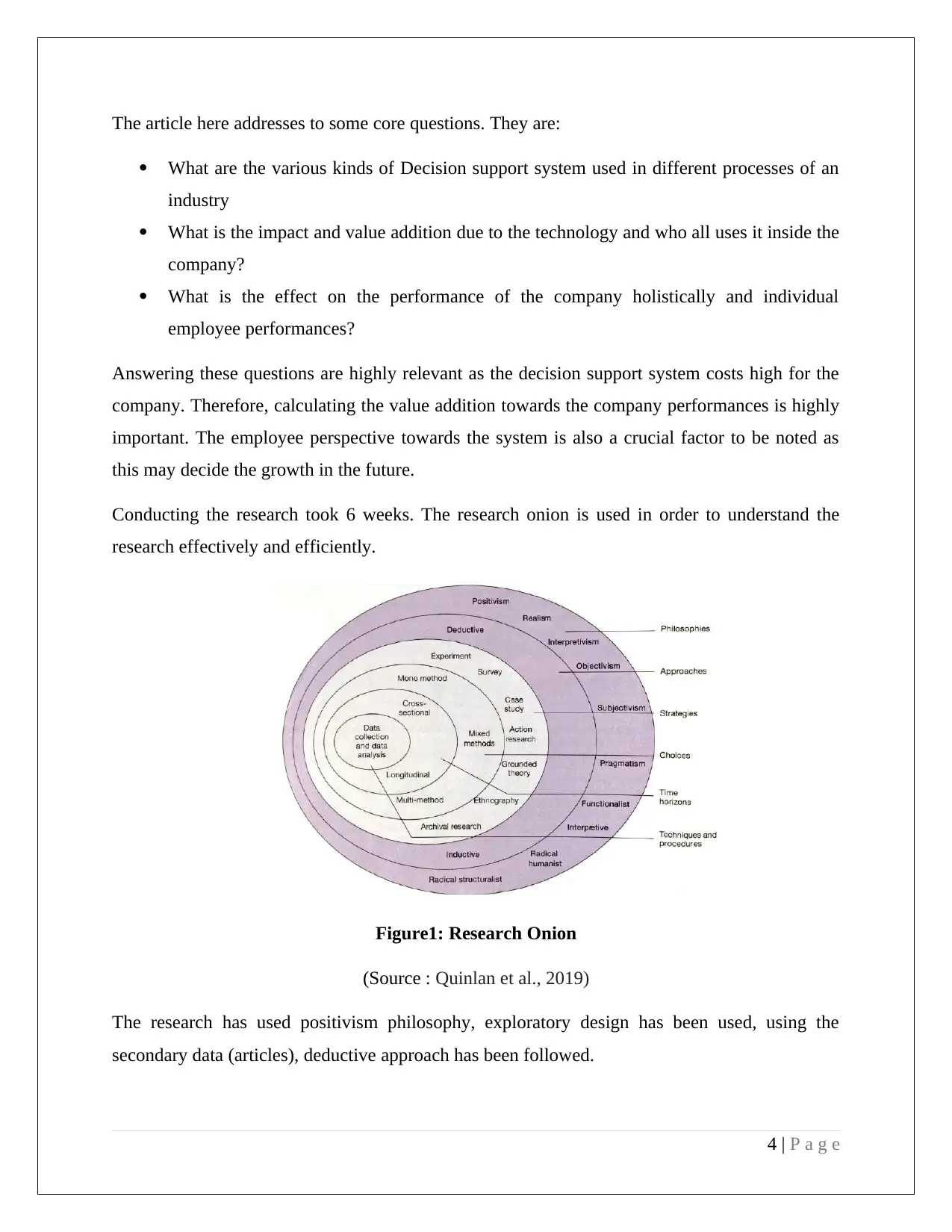
The article here addresses to some core questions. They are:
What are the various kinds of Decision support system used in different processes of an
industry
What is the impact and value addition due to the technology and who all uses it inside the
company?
What is the effect on the performance of the company holistically and individual
employee performances?
Answering these questions are highly relevant as the decision support system costs high for the
company. Therefore, calculating the value addition towards the company performances is highly
important. The employee perspective towards the system is also a crucial factor to be noted as
this may decide the growth in the future.
Conducting the research took 6 weeks. The research onion is used in order to understand the
research effectively and efficiently.
Figure1: Research Onion
(Source : Quinlan et al., 2019)
The research has used positivism philosophy, exploratory design has been used, using the
secondary data (articles), deductive approach has been followed.
4 | P a g e
What are the various kinds of Decision support system used in different processes of an
industry
What is the impact and value addition due to the technology and who all uses it inside the
company?
What is the effect on the performance of the company holistically and individual
employee performances?
Answering these questions are highly relevant as the decision support system costs high for the
company. Therefore, calculating the value addition towards the company performances is highly
important. The employee perspective towards the system is also a crucial factor to be noted as
this may decide the growth in the future.
Conducting the research took 6 weeks. The research onion is used in order to understand the
research effectively and efficiently.
Figure1: Research Onion
(Source : Quinlan et al., 2019)
The research has used positivism philosophy, exploratory design has been used, using the
secondary data (articles), deductive approach has been followed.
4 | P a g e
Paraphrase This Document
Need a fresh take? Get an instant paraphrase of this document with our AI Paraphraser
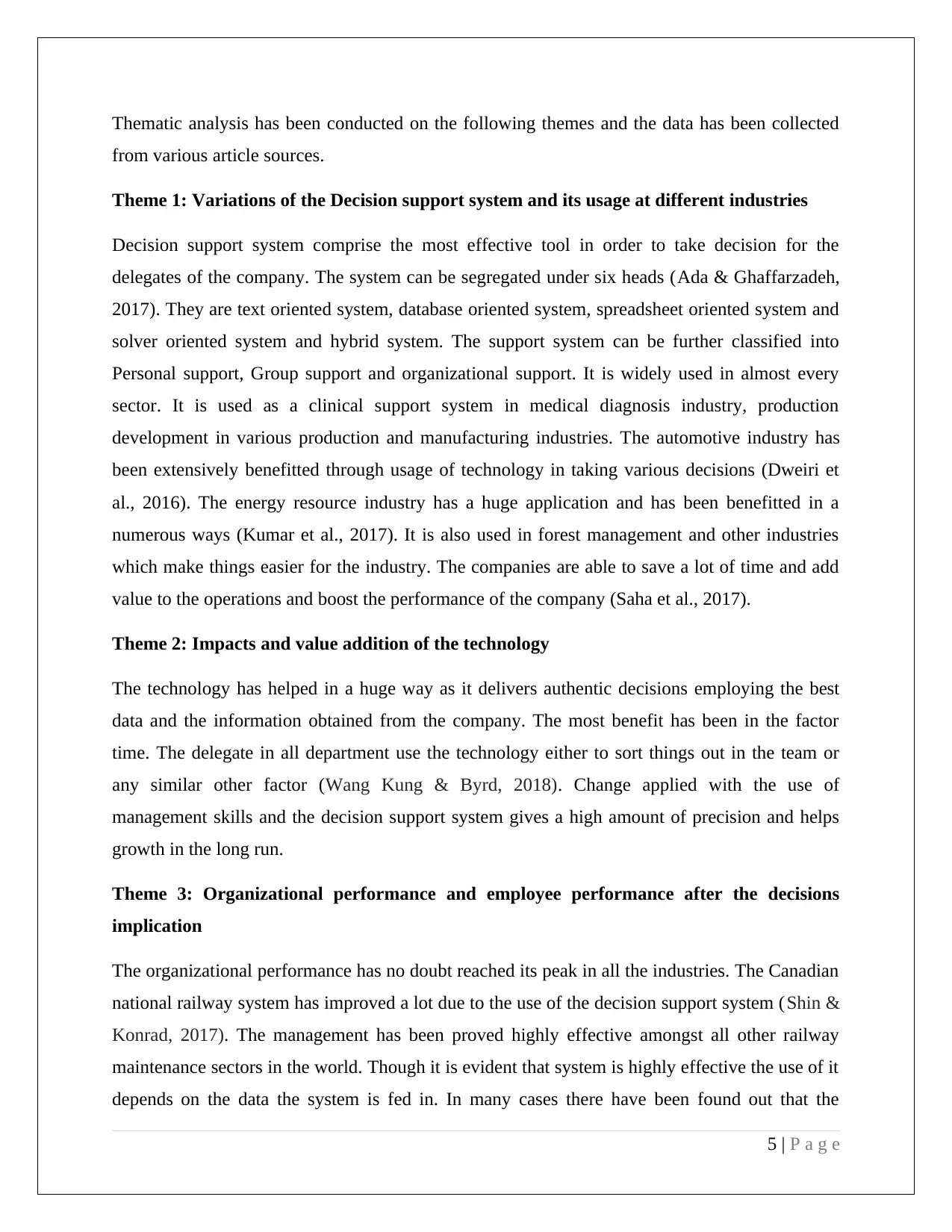
Thematic analysis has been conducted on the following themes and the data has been collected
from various article sources.
Theme 1: Variations of the Decision support system and its usage at different industries
Decision support system comprise the most effective tool in order to take decision for the
delegates of the company. The system can be segregated under six heads (Ada & Ghaffarzadeh,
2017). They are text oriented system, database oriented system, spreadsheet oriented system and
solver oriented system and hybrid system. The support system can be further classified into
Personal support, Group support and organizational support. It is widely used in almost every
sector. It is used as a clinical support system in medical diagnosis industry, production
development in various production and manufacturing industries. The automotive industry has
been extensively benefitted through usage of technology in taking various decisions (Dweiri et
al., 2016). The energy resource industry has a huge application and has been benefitted in a
numerous ways (Kumar et al., 2017). It is also used in forest management and other industries
which make things easier for the industry. The companies are able to save a lot of time and add
value to the operations and boost the performance of the company (Saha et al., 2017).
Theme 2: Impacts and value addition of the technology
The technology has helped in a huge way as it delivers authentic decisions employing the best
data and the information obtained from the company. The most benefit has been in the factor
time. The delegate in all department use the technology either to sort things out in the team or
any similar other factor (Wang Kung & Byrd, 2018). Change applied with the use of
management skills and the decision support system gives a high amount of precision and helps
growth in the long run.
Theme 3: Organizational performance and employee performance after the decisions
implication
The organizational performance has no doubt reached its peak in all the industries. The Canadian
national railway system has improved a lot due to the use of the decision support system (Shin &
Konrad, 2017). The management has been proved highly effective amongst all other railway
maintenance sectors in the world. Though it is evident that system is highly effective the use of it
depends on the data the system is fed in. In many cases there have been found out that the
5 | P a g e
from various article sources.
Theme 1: Variations of the Decision support system and its usage at different industries
Decision support system comprise the most effective tool in order to take decision for the
delegates of the company. The system can be segregated under six heads (Ada & Ghaffarzadeh,
2017). They are text oriented system, database oriented system, spreadsheet oriented system and
solver oriented system and hybrid system. The support system can be further classified into
Personal support, Group support and organizational support. It is widely used in almost every
sector. It is used as a clinical support system in medical diagnosis industry, production
development in various production and manufacturing industries. The automotive industry has
been extensively benefitted through usage of technology in taking various decisions (Dweiri et
al., 2016). The energy resource industry has a huge application and has been benefitted in a
numerous ways (Kumar et al., 2017). It is also used in forest management and other industries
which make things easier for the industry. The companies are able to save a lot of time and add
value to the operations and boost the performance of the company (Saha et al., 2017).
Theme 2: Impacts and value addition of the technology
The technology has helped in a huge way as it delivers authentic decisions employing the best
data and the information obtained from the company. The most benefit has been in the factor
time. The delegate in all department use the technology either to sort things out in the team or
any similar other factor (Wang Kung & Byrd, 2018). Change applied with the use of
management skills and the decision support system gives a high amount of precision and helps
growth in the long run.
Theme 3: Organizational performance and employee performance after the decisions
implication
The organizational performance has no doubt reached its peak in all the industries. The Canadian
national railway system has improved a lot due to the use of the decision support system (Shin &
Konrad, 2017). The management has been proved highly effective amongst all other railway
maintenance sectors in the world. Though it is evident that system is highly effective the use of it
depends on the data the system is fed in. In many cases there have been found out that the
5 | P a g e
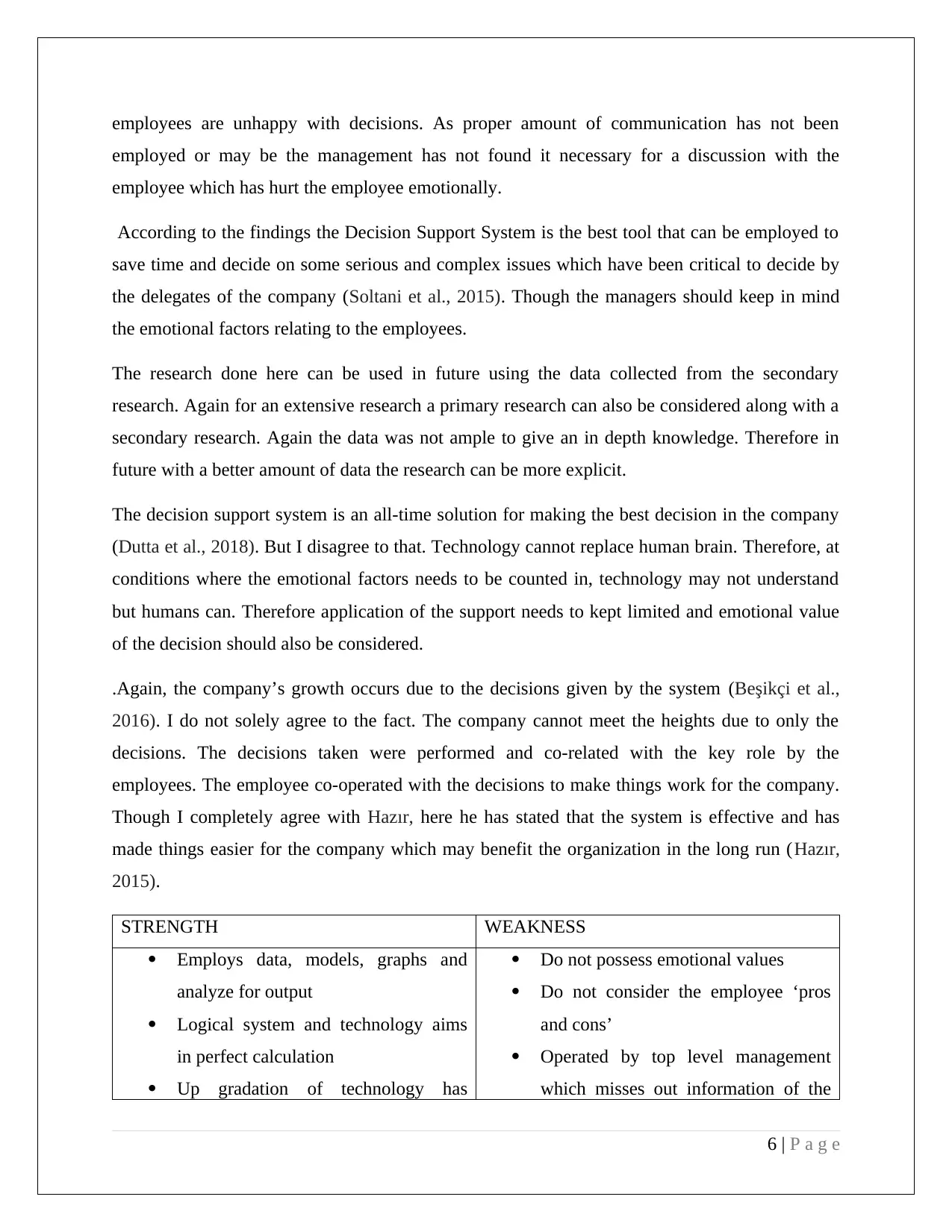
employees are unhappy with decisions. As proper amount of communication has not been
employed or may be the management has not found it necessary for a discussion with the
employee which has hurt the employee emotionally.
According to the findings the Decision Support System is the best tool that can be employed to
save time and decide on some serious and complex issues which have been critical to decide by
the delegates of the company (Soltani et al., 2015). Though the managers should keep in mind
the emotional factors relating to the employees.
The research done here can be used in future using the data collected from the secondary
research. Again for an extensive research a primary research can also be considered along with a
secondary research. Again the data was not ample to give an in depth knowledge. Therefore in
future with a better amount of data the research can be more explicit.
The decision support system is an all-time solution for making the best decision in the company
(Dutta et al., 2018). But I disagree to that. Technology cannot replace human brain. Therefore, at
conditions where the emotional factors needs to be counted in, technology may not understand
but humans can. Therefore application of the support needs to kept limited and emotional value
of the decision should also be considered.
.Again, the company’s growth occurs due to the decisions given by the system (Beşikçi et al.,
2016). I do not solely agree to the fact. The company cannot meet the heights due to only the
decisions. The decisions taken were performed and co-related with the key role by the
employees. The employee co-operated with the decisions to make things work for the company.
Though I completely agree with Hazır, here he has stated that the system is effective and has
made things easier for the company which may benefit the organization in the long run (Hazır,
2015).
STRENGTH WEAKNESS
Employs data, models, graphs and
analyze for output
Logical system and technology aims
in perfect calculation
Up gradation of technology has
Do not possess emotional values
Do not consider the employee ‘pros
and cons’
Operated by top level management
which misses out information of the
6 | P a g e
employed or may be the management has not found it necessary for a discussion with the
employee which has hurt the employee emotionally.
According to the findings the Decision Support System is the best tool that can be employed to
save time and decide on some serious and complex issues which have been critical to decide by
the delegates of the company (Soltani et al., 2015). Though the managers should keep in mind
the emotional factors relating to the employees.
The research done here can be used in future using the data collected from the secondary
research. Again for an extensive research a primary research can also be considered along with a
secondary research. Again the data was not ample to give an in depth knowledge. Therefore in
future with a better amount of data the research can be more explicit.
The decision support system is an all-time solution for making the best decision in the company
(Dutta et al., 2018). But I disagree to that. Technology cannot replace human brain. Therefore, at
conditions where the emotional factors needs to be counted in, technology may not understand
but humans can. Therefore application of the support needs to kept limited and emotional value
of the decision should also be considered.
.Again, the company’s growth occurs due to the decisions given by the system (Beşikçi et al.,
2016). I do not solely agree to the fact. The company cannot meet the heights due to only the
decisions. The decisions taken were performed and co-related with the key role by the
employees. The employee co-operated with the decisions to make things work for the company.
Though I completely agree with Hazır, here he has stated that the system is effective and has
made things easier for the company which may benefit the organization in the long run (Hazır,
2015).
STRENGTH WEAKNESS
Employs data, models, graphs and
analyze for output
Logical system and technology aims
in perfect calculation
Up gradation of technology has
Do not possess emotional values
Do not consider the employee ‘pros
and cons’
Operated by top level management
which misses out information of the
6 | P a g e
⊘ This is a preview!⊘
Do you want full access?
Subscribe today to unlock all pages.

Trusted by 1+ million students worldwide
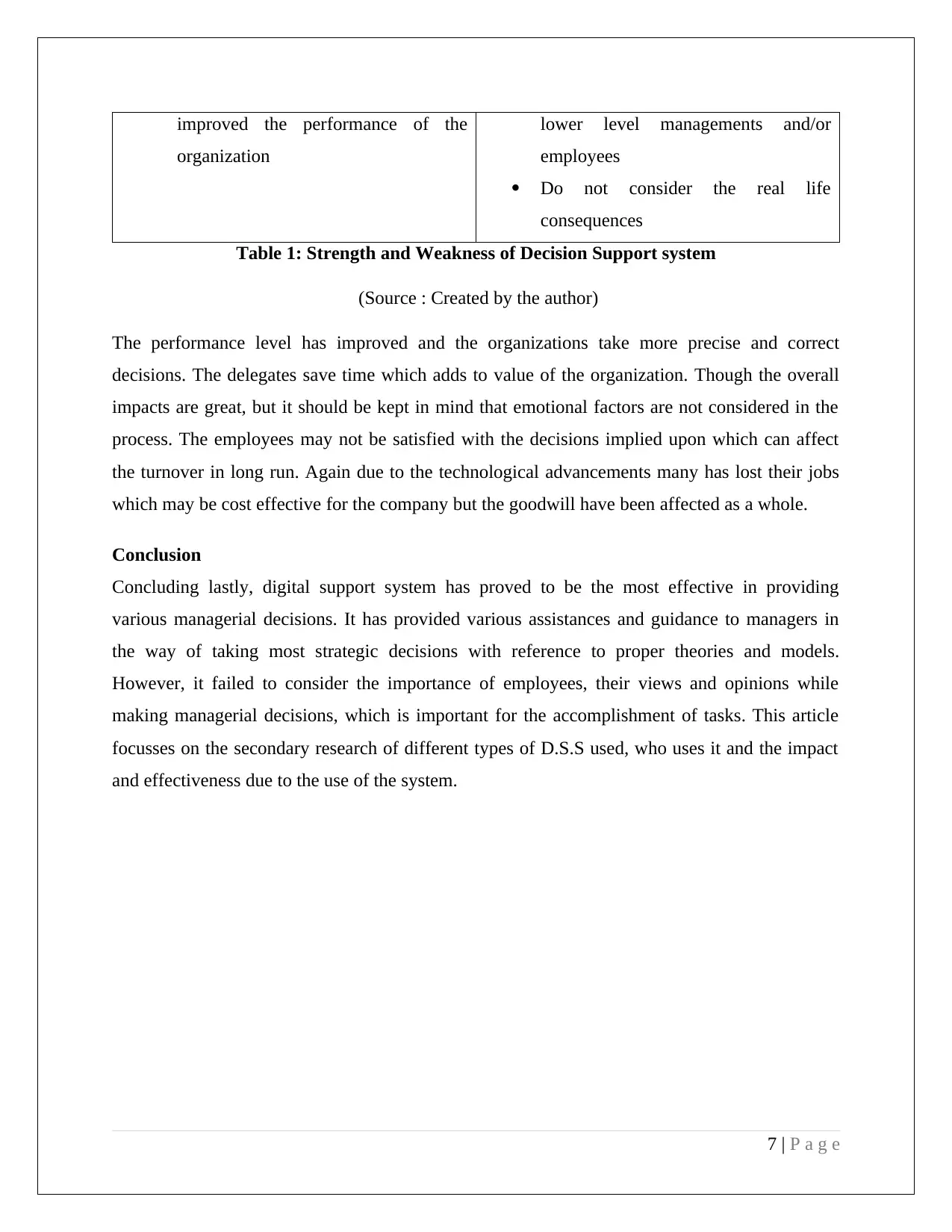
improved the performance of the
organization
lower level managements and/or
employees
Do not consider the real life
consequences
Table 1: Strength and Weakness of Decision Support system
(Source : Created by the author)
The performance level has improved and the organizations take more precise and correct
decisions. The delegates save time which adds to value of the organization. Though the overall
impacts are great, but it should be kept in mind that emotional factors are not considered in the
process. The employees may not be satisfied with the decisions implied upon which can affect
the turnover in long run. Again due to the technological advancements many has lost their jobs
which may be cost effective for the company but the goodwill have been affected as a whole.
Conclusion
Concluding lastly, digital support system has proved to be the most effective in providing
various managerial decisions. It has provided various assistances and guidance to managers in
the way of taking most strategic decisions with reference to proper theories and models.
However, it failed to consider the importance of employees, their views and opinions while
making managerial decisions, which is important for the accomplishment of tasks. This article
focusses on the secondary research of different types of D.S.S used, who uses it and the impact
and effectiveness due to the use of the system.
7 | P a g e
organization
lower level managements and/or
employees
Do not consider the real life
consequences
Table 1: Strength and Weakness of Decision Support system
(Source : Created by the author)
The performance level has improved and the organizations take more precise and correct
decisions. The delegates save time which adds to value of the organization. Though the overall
impacts are great, but it should be kept in mind that emotional factors are not considered in the
process. The employees may not be satisfied with the decisions implied upon which can affect
the turnover in long run. Again due to the technological advancements many has lost their jobs
which may be cost effective for the company but the goodwill have been affected as a whole.
Conclusion
Concluding lastly, digital support system has proved to be the most effective in providing
various managerial decisions. It has provided various assistances and guidance to managers in
the way of taking most strategic decisions with reference to proper theories and models.
However, it failed to consider the importance of employees, their views and opinions while
making managerial decisions, which is important for the accomplishment of tasks. This article
focusses on the secondary research of different types of D.S.S used, who uses it and the impact
and effectiveness due to the use of the system.
7 | P a g e
Paraphrase This Document
Need a fresh take? Get an instant paraphrase of this document with our AI Paraphraser
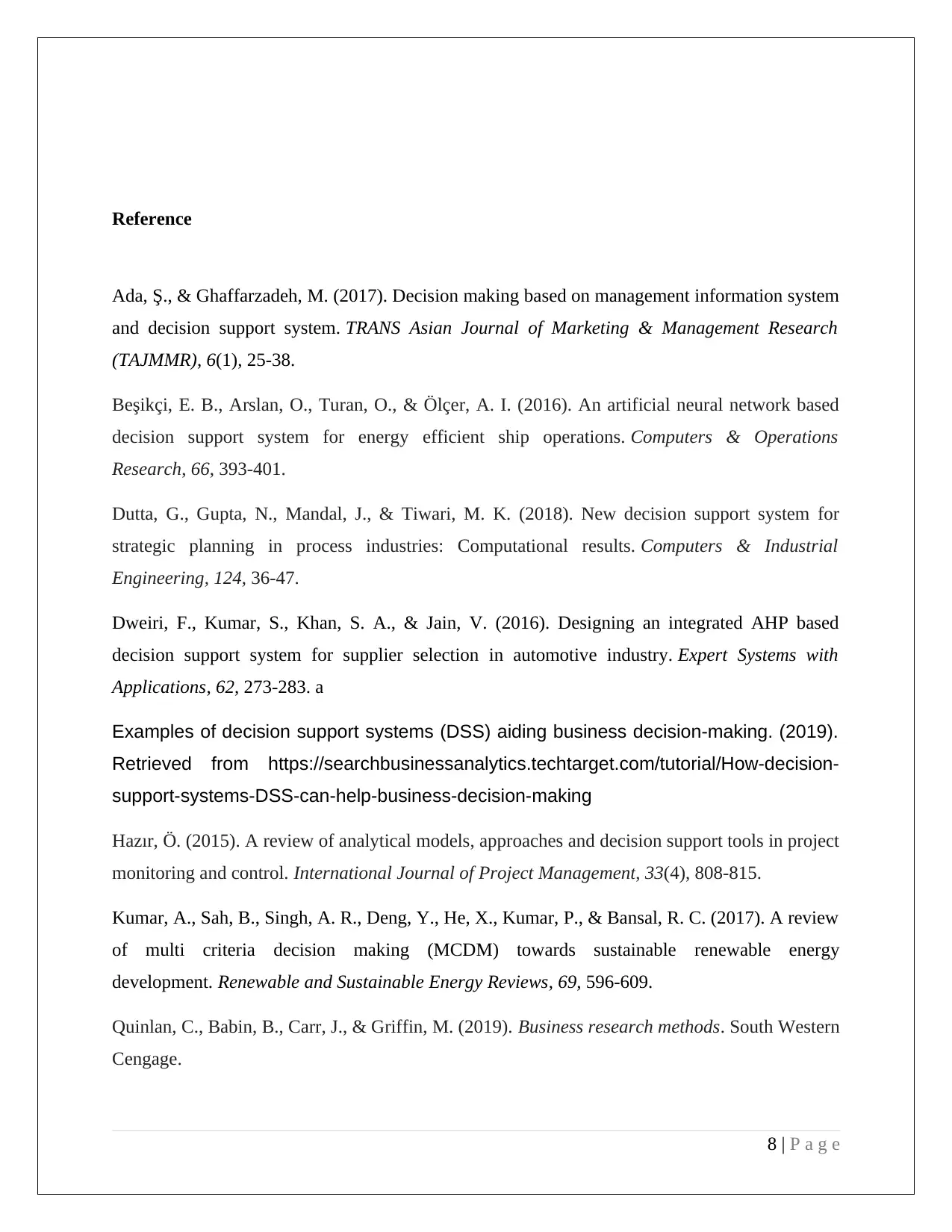
Reference
Ada, Ş., & Ghaffarzadeh, M. (2017). Decision making based on management information system
and decision support system. TRANS Asian Journal of Marketing & Management Research
(TAJMMR), 6(1), 25-38.
Beşikçi, E. B., Arslan, O., Turan, O., & Ölçer, A. I. (2016). An artificial neural network based
decision support system for energy efficient ship operations. Computers & Operations
Research, 66, 393-401.
Dutta, G., Gupta, N., Mandal, J., & Tiwari, M. K. (2018). New decision support system for
strategic planning in process industries: Computational results. Computers & Industrial
Engineering, 124, 36-47.
Dweiri, F., Kumar, S., Khan, S. A., & Jain, V. (2016). Designing an integrated AHP based
decision support system for supplier selection in automotive industry. Expert Systems with
Applications, 62, 273-283. a
Examples of decision support systems (DSS) aiding business decision-making. (2019).
Retrieved from https://searchbusinessanalytics.techtarget.com/tutorial/How-decision-
support-systems-DSS-can-help-business-decision-making
Hazır, Ö. (2015). A review of analytical models, approaches and decision support tools in project
monitoring and control. International Journal of Project Management, 33(4), 808-815.
Kumar, A., Sah, B., Singh, A. R., Deng, Y., He, X., Kumar, P., & Bansal, R. C. (2017). A review
of multi criteria decision making (MCDM) towards sustainable renewable energy
development. Renewable and Sustainable Energy Reviews, 69, 596-609.
Quinlan, C., Babin, B., Carr, J., & Griffin, M. (2019). Business research methods. South Western
Cengage.
8 | P a g e
Ada, Ş., & Ghaffarzadeh, M. (2017). Decision making based on management information system
and decision support system. TRANS Asian Journal of Marketing & Management Research
(TAJMMR), 6(1), 25-38.
Beşikçi, E. B., Arslan, O., Turan, O., & Ölçer, A. I. (2016). An artificial neural network based
decision support system for energy efficient ship operations. Computers & Operations
Research, 66, 393-401.
Dutta, G., Gupta, N., Mandal, J., & Tiwari, M. K. (2018). New decision support system for
strategic planning in process industries: Computational results. Computers & Industrial
Engineering, 124, 36-47.
Dweiri, F., Kumar, S., Khan, S. A., & Jain, V. (2016). Designing an integrated AHP based
decision support system for supplier selection in automotive industry. Expert Systems with
Applications, 62, 273-283. a
Examples of decision support systems (DSS) aiding business decision-making. (2019).
Retrieved from https://searchbusinessanalytics.techtarget.com/tutorial/How-decision-
support-systems-DSS-can-help-business-decision-making
Hazır, Ö. (2015). A review of analytical models, approaches and decision support tools in project
monitoring and control. International Journal of Project Management, 33(4), 808-815.
Kumar, A., Sah, B., Singh, A. R., Deng, Y., He, X., Kumar, P., & Bansal, R. C. (2017). A review
of multi criteria decision making (MCDM) towards sustainable renewable energy
development. Renewable and Sustainable Energy Reviews, 69, 596-609.
Quinlan, C., Babin, B., Carr, J., & Griffin, M. (2019). Business research methods. South Western
Cengage.
8 | P a g e
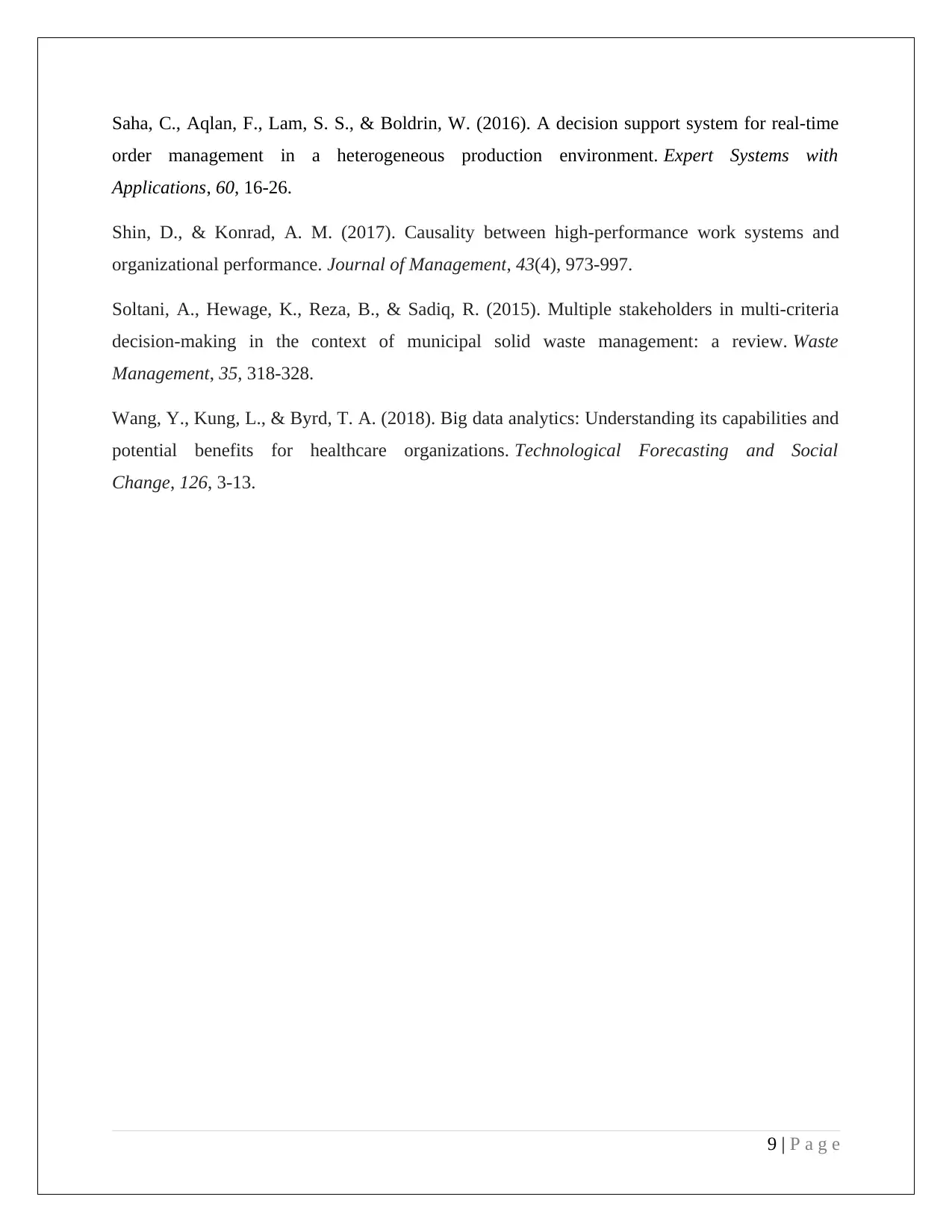
Saha, C., Aqlan, F., Lam, S. S., & Boldrin, W. (2016). A decision support system for real-time
order management in a heterogeneous production environment. Expert Systems with
Applications, 60, 16-26.
Shin, D., & Konrad, A. M. (2017). Causality between high-performance work systems and
organizational performance. Journal of Management, 43(4), 973-997.
Soltani, A., Hewage, K., Reza, B., & Sadiq, R. (2015). Multiple stakeholders in multi-criteria
decision-making in the context of municipal solid waste management: a review. Waste
Management, 35, 318-328.
Wang, Y., Kung, L., & Byrd, T. A. (2018). Big data analytics: Understanding its capabilities and
potential benefits for healthcare organizations. Technological Forecasting and Social
Change, 126, 3-13.
9 | P a g e
order management in a heterogeneous production environment. Expert Systems with
Applications, 60, 16-26.
Shin, D., & Konrad, A. M. (2017). Causality between high-performance work systems and
organizational performance. Journal of Management, 43(4), 973-997.
Soltani, A., Hewage, K., Reza, B., & Sadiq, R. (2015). Multiple stakeholders in multi-criteria
decision-making in the context of municipal solid waste management: a review. Waste
Management, 35, 318-328.
Wang, Y., Kung, L., & Byrd, T. A. (2018). Big data analytics: Understanding its capabilities and
potential benefits for healthcare organizations. Technological Forecasting and Social
Change, 126, 3-13.
9 | P a g e
⊘ This is a preview!⊘
Do you want full access?
Subscribe today to unlock all pages.

Trusted by 1+ million students worldwide
1 out of 9
Related Documents
Your All-in-One AI-Powered Toolkit for Academic Success.
+13062052269
info@desklib.com
Available 24*7 on WhatsApp / Email
![[object Object]](/_next/static/media/star-bottom.7253800d.svg)
Unlock your academic potential
Copyright © 2020–2025 A2Z Services. All Rights Reserved. Developed and managed by ZUCOL.





